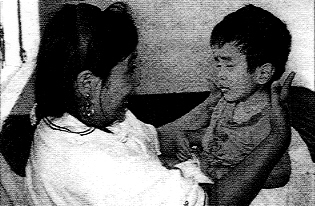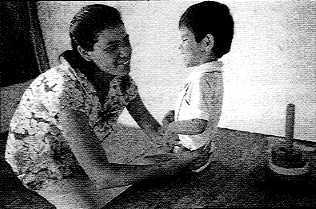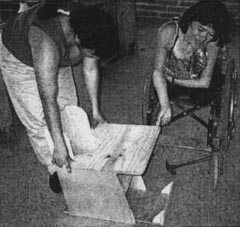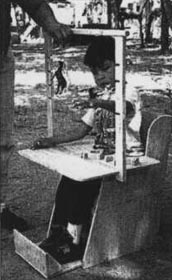Nothing About Us Without Us
Developing Innovative Technologies
For , By and With Disabled Persons
Part One
THE PURPOSE OF SPECIAL SEATING:
Freedom and Development, Not Confinement
CHAPTER 2
Seats with Changing Positions
to Meet Jazmin's Different Needs
Need for Seating that Adjusts to Help a Child Gain Greater Body Control
Especially for the child whose body is floppy and has little head control, it is important that seating be designed so as to help the child gain more trunk (body) and head control. Before designing the seat, it is a good idea to check how much head control and trunk control the child has, by holding him in a sitting position, It is often best for the mother or family member to do this, and it is essential that she understand the principles involved.
|
To check head control, sit the child on your lap or on a firm object. With your hands, provide just enough shoulder or trunk support to keep the child sitting upright. With your fingertips, position the head straight up. Then gently lessen the head support to see if the child can hold (or partly hold) his head up, even for a moment. Catch the child's head softly with your fingertips when it begins to fall. |
To check trunk (body) control, sit the child firmly and hold his body just under his arms. Gradually move your hands lower on his body to find out how low the support can be for him to keep in an upright position. If he can keep his balance and remain sitting upright when you hold him low at the hips, he is developing fairly good trunk control. This boy's mother was surprised at how much trunk control her son had. |
These two activities, used here for evaluation, can also be used to improve a child's head control, trunk control, and balance. Do them several times a day. As a general rule:
Use the least amount of support needed to help the child do the most she can for herself.
For special seating, this same principle applies. It is often helpful if the seating is adjustable, allowing the child to sit in positions for stimulation as well as for relaxation.
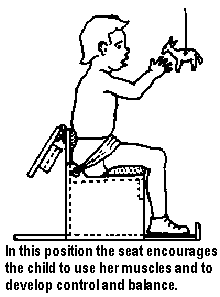
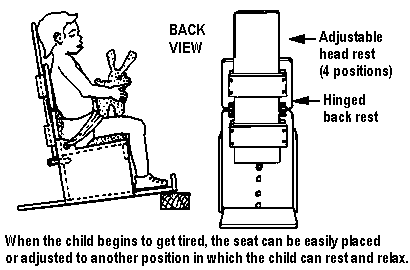
For Jazmin - A Seat That Changes Position
JAZMIN was 3 years old when her mother first brought her to PROJIMO. Her brain had been damaged at birth. She still had almost no head control. When her mother tried to sit her up, her head fell forward and her body flopped to one side. She had spent most of her life lying in a crib. At PROJIMO, Mari (one of the coordinators of the program) showed Jazmin's mother several activities that she could do to help Jazmin gain more head control. These included the "fingertips at the base of the skull" activity shown on page 37.
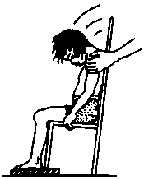
After working with Jazmin's mother to evaluate her daughter's abilities and needs, Mario (a carpenter who is paraplegic) and Mari designed and made a special seat for her. It was basically a plywood box with the seat, the back, and width measured to her size.
Jazmin's large head tended to fall forward even when she was tilted somewhat back. So Mario made a headrest that angled backward from the seat back. That way, Jazmin could rest her head against the headrest without her head falling forward. But although this let her rest comfortably, it did little to help her gain head control. For this reason a piece of plywood was prepared, with slits of different lengths, so that it could lift the back of the seat to different heights. A soft chest band helped to keep her from slumping forward.
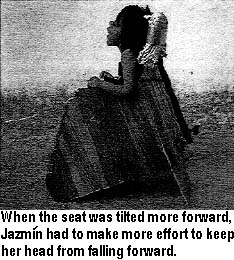
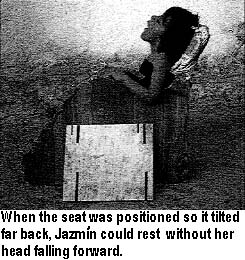
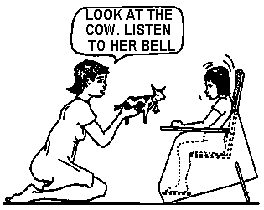
Because the angle of the seat could be adjusted securely in 5 different positions, her mother could experiment, seeking the angle at which Jazmin was barely able to keep her head upright. Over time, this would help her develop head control. As her control improved with the combination of special seating and fingertip exercises, her mother could leave Jazmin sitting longer in the upright position before letting her rest in the back-slanting position. And, little by little, she could tilt the seat further forward, encouraging yet further improvement in head control.
Mari also encouraged Jazmin's mother to talk with her daughter when she did any activity with her. Jazmin's mother learned to move bright colored objects in front of her face, encouraging her to follow them with her eyes and to try to lift her head.
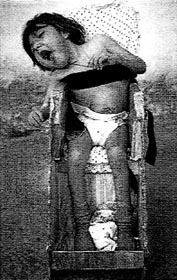
A problem with Jazmin's seat was that her body still tended to flop over to the right, with her head hanging over the side of the seat.
To help Jazmin sit straighter, the team made wedges of layered cardboard and positioned them to hold her hips in place and to center her body. But still, her body and head flopped far over to the right side.
By experimenting with her hands, Mari found that when Jazmin's head was supported gently on the right side, this kept her upper body from flopping over to the right. She thought a head support on the right side would help. But it should be easily removable. Removing it at times might help Jazmin become less dependent on it, and it might encourage her to keep her body and head upright. Eventually, the side-support might not be needed.
Armando made a simple, easily removable, side-of-the-head support by heating a piece of sheet plastic over a flame and bending it as shown below.
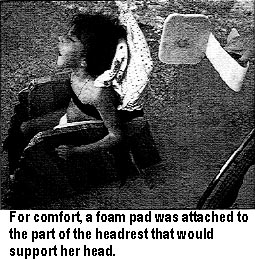
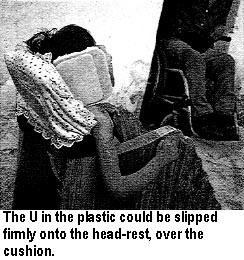
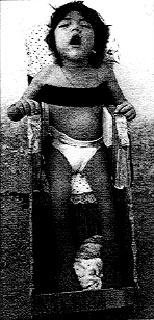
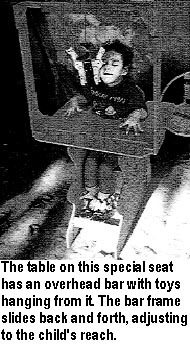
With the right side of her head supported in this way, Jazmin could sit much straighter. The thin plastic support was rather flexible, so that when Jazmin pushed her head against it, it would bend a bit. This permitted some head motion. Yet when she stopped pushing, the support would gently move her head to a straighter position.
With the help of head-control exercises and a special seat designed to meet her needs, together with more stimulation by her mother, brothers, and sister, Jazmin began to gain better head control. Once she could hold her head up, she took more notice of action and movements around her.
Adjustable-position seating designs similar to the one made for Jazmin have been modified and adapted by PROJIMO to meet the needs of many different children. Here is an example of a seat for a baby named FATIMA, who had floppy cerebral palsy and developmental delay.
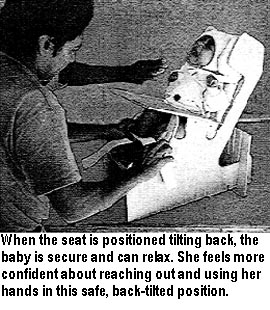
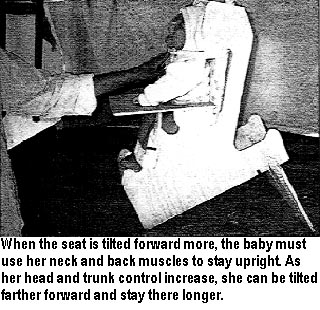
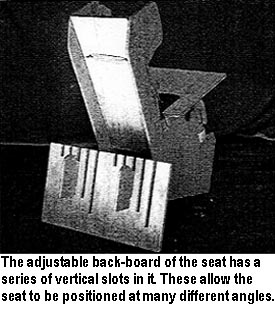
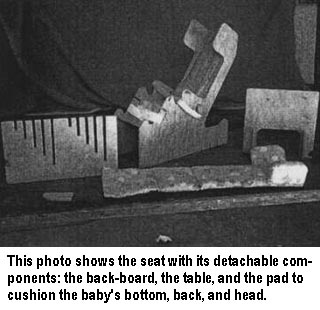
Many of the seats built at PROJIMO include an adjustable overhead bar from which colorful toys, rattles, and bells can be hung. These attract the child's attention and stimulate her to lift her head, reach out, and start to develop hand-eye coordination.
|
The mother of Tinin, a child with cerebral palsy, helps Irma build a special wooden seat for him. |
Irma and Tinin's mother attached a bar that can be adjusted over the table. Toys hung from the bar encourage the boy to lift his head and to use his hands. (For more on Tinin see pages 54-55.) |
Nothing About Us Without Us
Developing Innovative Technologies
For, By and With Disabled Persons
by David Werner
Published by
HealthWrights
Workgroup for People's Health and Rights
Post Office Box 1344
Palo Alto, CA 94302, USA

